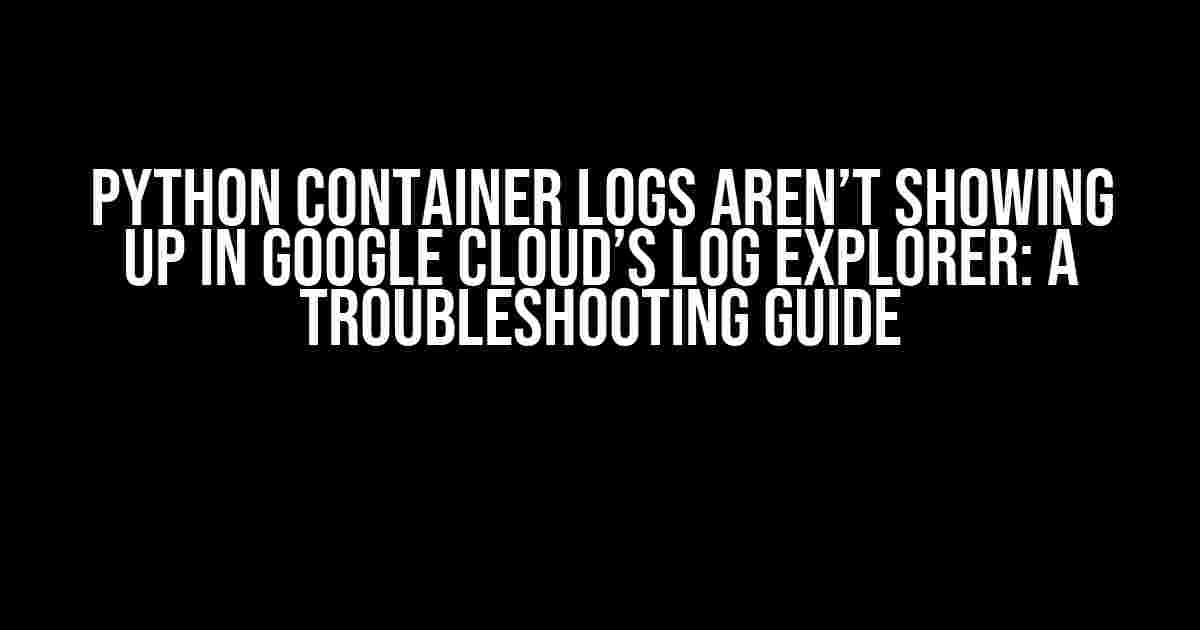Are you struggling to get your Python container logs to show up in Google Cloud’s Log Explorer? You’re not alone! Many developers have faced this frustrating issue, but don’t worry, we’ve got you covered. In this article, we’ll dive into the common causes and provide step-by-step solutions to get your logs flowing smoothly into Log Explorer.
Understanding Google Cloud Logging and Container Logs
Before we dive into troubleshooting, let’s take a brief look at how Google Cloud Logging and container logs work together.
Google Cloud Logging is a fully-managed service that allows you to collect, process, and analyze log data from your applications and services. Container logs, on the other hand, are logs generated by your containerized applications, such as those running on Kubernetes or Cloud Run.
When you configure your container to send logs to Cloud Logging, the logs are forwarded to Cloud Logging, where they can be viewed, filtered, and analyzed using the Log Explorer.
So, why aren’t your Python container logs showing up in Log Explorer? Here are some common causes:
- Incorrect Log Configuration: Misconfigured logging settings can prevent logs from being sent to Cloud Logging.
- Logging Agent Issues: The logging agent responsible for forwarding logs to Cloud Logging might be malfunctioning or not installed correctly.
- Container Runtime Issues: container runtime issues, such as Docker or rkt, can prevent logs from being generated or sent to Cloud Logging.
- Network Connectivity Issues: Network connectivity problems can prevent logs from being transmitted to Cloud Logging.
- Permission Issues: Insufficient permissions or incorrect Identity and Access Management (IAM) roles can prevent logs from being sent to Cloud Logging.
Troubleshooting Steps
Now that we’ve covered the common causes, let’s walk through step-by-step troubleshooting to get your Python container logs showing up in Log Explorer.
Step 1: Verify Logging Configuration
Check your logging configuration to ensure it’s set up correctly. You can do this by:
- Verifying that the logging agent is installed and running on your container.
- Checking the logging configuration file (e.g., `logging.json` or `logging.conf`) to ensure it’s pointing to the correct Cloud Logging project and log sink.
- Confirming that the logging level is set to the desired level (e.g., INFO, DEBUG, etc.).
# Example logging.json file
{
"version": "2",
"formatters": {
"default_formatter": {
"format": "%(asctime)s - %(name)s - %(levelname)s - %(message)s"
}
},
"handlers": {
"console_handler": {
"class": "logging.StreamHandler",
"formatter": "default_formatter",
"stream": "ext://sys.stdout"
},
"cloud_handler": {
"class": "google.cloud.logging.handlers.CloudLoggingHandler",
"project_id": "your-project-id",
"instance_id": "your-instance-id"
}
},
"loggers": {
"root": {
"level": "INFO",
"handlers": ["console_handler", "cloud_handler"]
}
}
}
Step 2: Check Logging Agent Status
Verify that the logging agent is running and functioning correctly. You can do this by:
- Checking the logging agent’s status using the command `sudo systemctl status google-logging-agent` (for Linux-based systems).
- Reviewing the logging agent’s logs to ensure there are no errors or issues.
# Example logging agent status output
Loaded: loaded (/etc/systemd/system/google-logging-agent.service; enabled; vendor preset: enabled)
Active: active (running) since Wed 2023-02-15 14:30:12 UTC; 2min 35s ago
```
Step 3: Verify Container Runtime
Confirm that your container runtime is correctly configured to generate and send logs to Cloud Logging. You can do this by:
- Checking the container runtime’s logs to ensure they are being generated and sent to Cloud Logging.
- Verifying that the container runtime is correctly configured to use the logging agent.
# Example Docker container runtime configuration
docker run -d \
--name my-container \
-e GOOGLE_APPLICATION_CREDENTIALS=/path/to/credentials.json \
-e LOGGINGprojectId=your-project-id \
-e LOGGINGinstanceId=your-instance-id \
my-image
Step 4: Check Network Connectivity
Verify that your container has network connectivity and can reach Cloud Logging. You can do this by:
- Ping testing Cloud Logging’s API endpoints to ensure connectivity.
- Checking the container’s network configuration to ensure it can reach Cloud Logging.
# Example ping test output
PING googlecloudlogging.googleapis.com (216.58.194.106) 56(84) bytes of data.
64 bytes from lb-in-f106.1e100.net (216.58.194.106): icmp_seq=1 ttl=57 time=26.9 ms
```
Step 5: Verify Permissions and IAM Roles
Confirm that your container has the necessary permissions and IAM roles to send logs to Cloud Logging. You can do this by:
- Verifying that the service account used by your container has the ` Logging/LogWriter` role.
- Checking the IAM policy to ensure it grants the necessary permissions to the service account.
# Example IAM policy output
{
"bindings": [
{
"role": "roles/logging.logWriter",
"members": [
"serviceAccount:your-service-account-email"
]
}
]
}
Solution: Setting Up Cloud Logging for Python Containers
Now that we’ve walked through the troubleshooting steps, let’s set up Cloud Logging for your Python container step-by-step:
Step 1: Install the Cloud Logging Library
Install the Cloud Logging library for Python using pip:
pip install google-cloud-logging
Step 2: Set Up Logging Configuration
Create a logging configuration file (`logging.json` or `logging.conf`) with the correct settings:
# Example logging.json file
{
"version": "2",
"formatters": {
"default_formatter": {
"format": "%(asctime)s - %(name)s - %(levelname)s - %(message)s"
}
},
"handlers": {
"console_handler": {
"class": "logging.StreamHandler",
"formatter": "default_formatter",
"stream": "ext://sys.stdout"
},
"cloud_handler": {
"class": "google.cloud.logging.handlers.CloudLoggingHandler",
"project_id": "your-project-id",
"instance_id": "your-instance-id"
}
},
"loggers": {
"root": {
"level": "INFO",
"handlers": ["console_handler", "cloud_handler"]
}
}
}
Step 3: Configure Your Container Runtime
Configure your container runtime to use the logging agent and send logs to Cloud Logging:
# Example Docker container runtime configuration
docker run -d \
--name my-container \
-e GOOGLE_APPLICATION_CREDENTIALS=/path/to/credentials.json \
-e LOGGINGprojectId=your-project-id \
-e LOGGINGinstanceId=your-instance-id \
my-image
Step 4: Verify Logs in Log Explorer
Verify that your logs are showing up in Log Explorer by checking the logs for your container:
- Go to the Google Cloud Console and navigate to the Log Explorer.
- Select the correct project and log sink.
- Filter the logs by the container’s name or instance ID.
| Log Level | Log Message | Timestamp |
|---|---|---|
| INFO | Container started successfully | 2023-02-15 14:30:12 UTC |
| DEBUG | Received request from client | 2023-02-15 14:30:15 UTC | Frequently Asked Question
